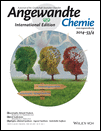The Strongest Brønsted Acid: Protonation of Alkanes by H(CHB11F11) at Room Temperature†
We thank Prof. Dr. Pingyun Feng and Dr. Richard W. Kondrat for kind assistance with H2 detection and GC/MS, respectively. This work was supported by the National Science Foundation (CHE 1144838 and CHE 0742001).
Graphical Abstract
What's eating you, alkane? The fluorinated carborane acid, H(CHB11F11), is shown to be the strongest Brønsted acid presently known. Remarkably, it protonates alkanes at room temperature. Stable carbocation salts are isolated. This novel superacid provides new opportunities to study the chemistry of hydrocarbon reforming.
Abstract
What is the strongest acid? Can a simple Brønsted acid be prepared that can protonate an alkane at room temperature? Can that acid be free of the complicating effects of added Lewis acids that are typical of common, difficult-to-handle superacid mixtures? The carborane superacid H(CHB11F11) is that acid. It is an extremely moisture-sensitive solid, prepared by treatment of anhydrous HCl with [Et3SiHSiEt3][CHB11F11]. It adds H2O to form [H3O][CHB11F11] and benzene to form the benzenium ion salt [C6H7][CHB11F11]. It reacts with butane to form a crystalline tBu+ salt and with n-hexane to form an isolable hexyl carbocation salt. Carbocations, which are thus no longer transient intermediates, react with NaH either by hydride addition to re-form an alkane or by deprotonation to form an alkene and H2. By protonating alkanes at room temperature, the reactivity of H(CHB11F11) opens up new opportunities for the easier study of acid-catalyzed hydrocarbon reforming.





